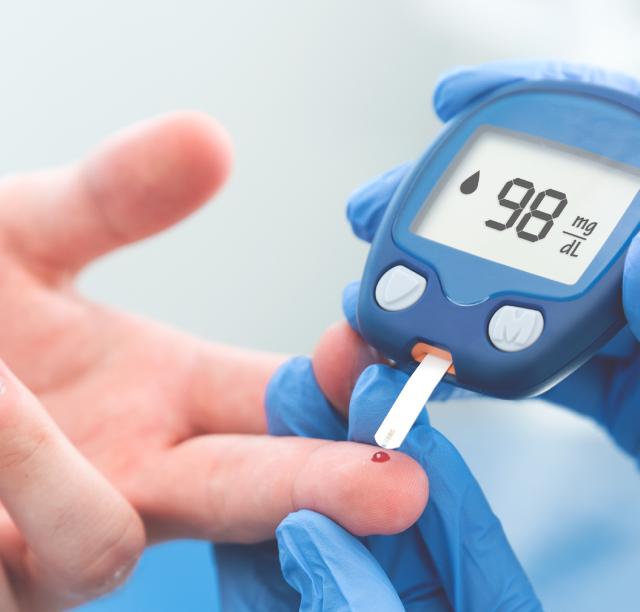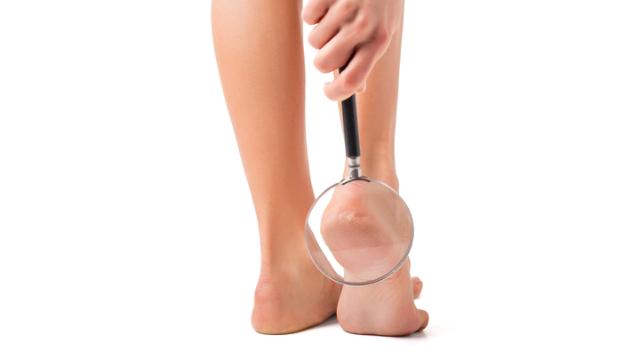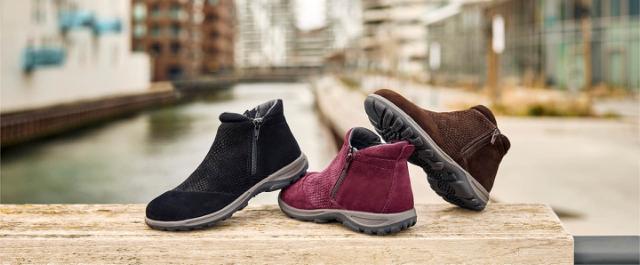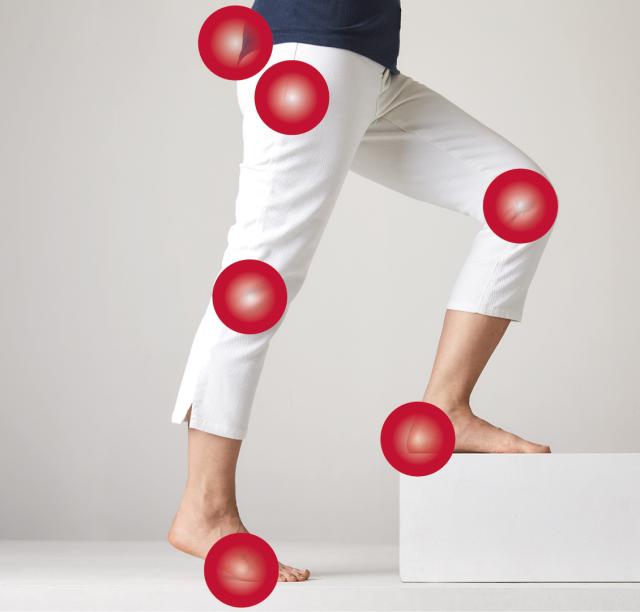Feet and diabetes
Diabetes changes your feet. We all need to take good care of our feet, but diabetes requires paying particular attention to your feet and being meticulous when choosing footwear.

What happens to your body?
Diabetes results in an elevated blood sugar level that is destructive to the sensory nerves and the nerves that control the sweat glands and other tissue structures. The nervous system is first gradually altered in the small and finest branches furthest from the brain and spinal cord. This gradually and unnoticeably takes away the sense of touch.
The small and larger branches of the bloodstream - arteries and capillary vessels - can also be destroyed over time. The feet are affected first and hardest as they have the longest supply pathways from the heart. With diabetes, muscles, skin and glands do not get the right control impulses from our nervous system. This means deterioration of the walking function and other functions of the foot.
It is important to take care of your feet
When you have diabetes (both type 1 & 2) one of the complications is impaired / weakened sense of touch (neuropathy). Neuropathy / sensory disorders in the feet means, among other things, that you cannot:
- Feel if your shoes are pinching
- Feel if there is a stone in your shoe
- Assess whether you have too much pressure on misalignments and bone protrusions so that the skin is damaged.
This can be the start of a foot ulcer. As a diabetic, there is a greater risk that the wound will become infected and that it will take a very long time to heal.
Things can have big consequences
In the worst case, an amputation may be the result of what started with a small blister on the little toe.
Pressure and friction are usually the triggering factors for ulceration. If sores occur, contact your doctor / practitioner immediately.
Late complications associated with diabetes?
The sense of touch in the feet can be impaired without you really noticing it. Sensory disturbance can result in tingling - prickling - burning - sleeping - cotton wool feeling in the feet at times. Many people experience that they have been walked with a stone in their shoe without noticing it, where it has developed into a wound.
Circulation can be reduced
The circulation in the feet and legs can be reduced and the shape of your foot can change - this leads to the risk of misalignments such as bunions, hammer toes or sunken forefoot.
Prevention
It is important that you, together with your doctor and practitioner, ensure optimal blood sugar control! The more even and stable blood sugar the better. A high blood sugar over time = a greater risk of complications!
Prevention is always easier and better than repairing, and one of the best things you can do for your feet is to go to a an professional practitioner regularly. They will check the senses, foot pulse and advises you on how to best take care of your feet. Based on your feet and your general state of health, the practicien will make a risk assessment, i.e. an assessment of your risk of developing foot ulcers.

Check your feet every day
Get to know your feet well, so you know if there are any changes and you can react to it right away.
- Check your skin
- Check your toes
- Check between your toes
- Check under your feet
If you cannot see the soles of your feet it might be a good idea to use a mirror, or get somebody to help if your vision is poor.
Your eyes may also change when you have diabetes so remember to have them checked.
Do you have symptoms?
Talk to your doctor, nurse or practicioner if you experience the following symptoms:
- Small wound
- Swelling
- Cracks in the skin (and between the toes)
- Dryness
- Inflammation
- Hard skin
- Redness of the skin
- Foot pain
- Ingrown nails
- Thickened nails
- Blood accumulation under the skin or nails
- Fungus
- Bunions and hammer toes
- Corns
- Blisters
Remember the daily care of your feet
What can you do yourself?
- Wash your feet every day - preferably with a shower.
- Use lukewarm water and very sparse use of skin-friendly soap.
- DO NOT use soft soap or soap shavings as it dries and degreases the skin!
- Avoid foot baths - it dries out the skin and destroys the skin's natural protection.
- Check the water temperature with your elbow - if you have reduced sensation in the feet, the water may be too hot and you may burn yourself.
- Dry thoroughly - remember to dry between the toes.
Applying cream to your feet to keep the skin elastic and intact is actually one of the most important things you can do to prevent sores from occurring.
NEVER put cream between your toes – there is usually plenty of moisture here already.
Never use:
- Foot file as it irritates the skin so that harder skin is formed, and when you have sensory disturbances, you cannot feel if you can file too much.
- Corns plaster as they can cause sores.
- Waterproof plasters as the healthy skin becomes soft and any wounds may worsen.
- NEVER puncture blood blisters - protect with a bandage - contact a practitioner.
Why should we do foot exercises?
If we are to be able to keep walking the 10,000 recommended steps daily, it is important that we train our feet.
The benefits of training your feet:
- Greater flexibility - If your feet are pliable and flexible, then your whole body can move better - this also gives better balance.
- Prevents injuries - Many problems with the knees, hips and back occur when the foot's suspension and turning function is impaired.
- Better blood circulation - Blood circulation is promoted, and you will find it easier to keep your feet warm and if you have swollen feet, it is really good to do articular pump exercises.
- Fast recovery - The more effortlessly and freely we move, the better we recover.
Wellness
If you want to stay healthy and fit all your life, it is important to have good and agile feet for as long as possible. Remember that practice makes perfect! And should you get muscle cramps during foot exercises… - then that is terrific – because you are using some muscles that you have not used for a while. Shake your foot slightly until the cramp is gone and continue with the exercises.
Choose some exercises that suit you and your level - remember it should be safe and fun.


Exercise is vital for your feet
We know that we need to move as much as possible as it is healthy. However, it is not easy to either walk or run if it hurts. If you have pain in your feet - ankle - hip - knee - back, get examined so you can do something about it or improve it.
Remember that you do not have to complete an Ironman Triathlon to do something good for yourself and your health. Regular walking - going for a walk is good for both the body and soul.
If you walk for half an hour every day, you can quickly feel that you can walk a little longer and a little faster each time. It is excellent for people with circulatory problems and an extremely easy way to lower your blood sugar!
There are numerous different ways to exercise and it is important that what you choose suits your level, needs and wishes.
Remember, exercise should be fun!
Your feet are the body's foundation - they must support you all your life
Choose the right footwear
There is so much footwear to choose from, and it can be hard to know what is good and sensible footwear. There is a difference between whether the footwear is to be worn for a party, everyday or exercise. Your daily footwear should be some of the best you have and good for your feet.
Footwear must protect your feet and help your gait to be as natural as possible. Shoes must fit your feet - your feet must not fit your shoes! Your footwear must be long enough and wide enough, and be able to be fastened to your foot with velcro or laces.
A good stable heel cap ensures that you get the support you need. There should also be plenty of room above your toes so there is no pressure. If you have hammer toes, it is particularly important that there is plenty of room.
It is also very important that there are no internal annoying seams. Remember to shake your footwear to remove any foreign objects before putting them on – you may not be able to feel small stones or anything else that could be in your footwear. Make sure to check your footwear at regular intervals to see if it still fits your feet as your feet continually change.
Sometimes it is not possible to find footwear that fits, and then an alternative can be hand-sewn footwear, or semi-orthopaedic footwear. Talk to your doctor, shoemaker or professional practitioner about this – and in some cases you may be referred further so that you can get a financial allowance.
There are some things diabetics should avoid:
- Do not go barefoot – you may not be able to feel what you are stepping on if you have sensory disturbances.
- Do not wear clogs – as the muscles of the foot cannot move normally.
- Do not wear toe rings, jewellery or sandals with a strap between the toes – the skin between the toes is too fragile.
Choice of socks
Socks should have plenty of room over the toes and not have seams or elastics that can cause pressure injuries. If you have swollen feet, talk to your doctor about the cause of the swelling and get treatment for it.
- Change socks everyday – or twice a day if you sweat a lot.
- Wool for cold feet.
- Cotton for hot feet.


Insoles for footwear
In many cases, an insole will alleviate your discomfort. An insole aims to relieve, support, correct or to some extent train your feet. This means that pressure is distributed so that the risk of hard skin, and so sores, is minimised.
Read more about our insole Korrektor® here
Many people also benefit greatly from getting a sole that is shock-absorbing as the body fat under the feet can diminish and you walk directly on your bones.
Read more about our 3 mm and 6 mm shock-absorbing soles here: Protektor®.
All footwear from New Feet has a 6 mm shock-absorbing sole inside the footwear.
Read more about New Feet footwear here.
In other cases, it is necessary to have a custom insole made according to your footprint.
You can but the best insoles in the world, but they are never better than the footwear they are put in. Make sure to get your footwear and insole "approved" by your practitioner who knows your feet, then you are more confident that it is the right choice.
Your feet are the body's foundation – they must support you all your life.
Have you been diagnosed with a disease?
If you have been diagnosed a disease that requires footwear and insoles, it is important that you listen to your practitioner's advice. Your own experiments can have serious consequences. Our resellers and us are happy to advise, but it is your practitioner who has access to your medical history. Therefore the practitioner's advice is very important.